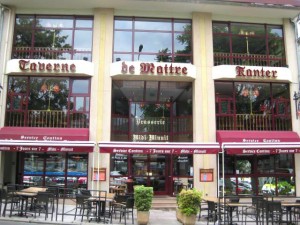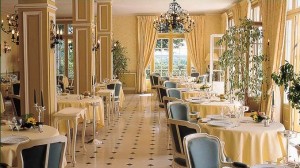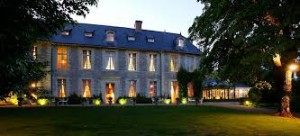The first place that I enjoyed a true French meal was at the Taverne de Maitre Kanter, which is located in the center of town. Going into dinner, the only thing I was told about the restaurant was that it was fancy. This left me with a lot of curiosity about what to expect from my first formal French dinner. When we arrived the sat us upstairs and began to take our drink orders, asking if we preferred red or white wine. When they brought the wine they also brought out some bread and butter. We all sat around sipping on wine, nibbling on bread, a leisurely having conversation until more food came out. The next course that they brought out was a couple slices of ham, a small salad, and two small pieces of bread. We all continued our conversation and slowly ate what was on our plates. The following course consisted of white rice and chicken. There was a delicious sauce that smothered the chicken and complimented it extremely well. The main course was amazing but what followed is what excited my taste buds the most. For desert we had chocolate cake and it was mouth- watering. To accompany this desert they brought out coffee and we ended dinner having a nice conversation over this warm delectable drink.
The second fancy meal that I was able to enjoy in France was at the Chateau de Noirieux. This meal was like the first in that it was extremely fancy and was a true French dining experience. We started of with water and white wine as we talked amongst the table. Shortly after some bread arrived and that didn’t stop us from talking, like it most likely would in the United States. After finishing the bread a cup of tomato sauce topped with tuna was brought out to the table. Although I personally do not like either of these things I tried it. I did not particularly like it but was excited to see that the next dish being served was salmon. This dish was better than the last but it still didn’t strike my taste buds. Next they brought out duck, accompanied by potatoes, and I knew that I was going to like this course. The flavor instantly took over my taste buds and was so delicious. For desert they brought out a sweet cake and was served with some coffee. The food may have tested my taboo line quite a bit but overall I thought the experience was fantastic.
My food experience in France has been extremelydifferent than what I am used to at home in the United States. The psychology around eating in France is not the same as it is at home. Nothing here is rushed and the whole meal revolves around the conversation of your table. The more you talk the longer your meal will last. This is much different than American culture when most meals are eaten at a very fast pace and once the food arrives most of the time people stop having their conversation and start eating their food. “Laughter is brightest in the place where the food is.” –Irish proverb (quotezine).
I believe that this quote embodies the French culture around eating. They are not worried about how long their dinner takes but about how the overall experience was. They love to sit and talk and laugh and enjoy the presence of their company; whereas, in the United States I believe the culture is more surrounded around the food and not the people. A typical meal in France lasts quite a while. The culture here is very slow and they take their time when they eat. They prefer to have conversation while they eat and to savor every bite; therefore, the meal is extended over multiple dishes and multiple hours. They take a bite of food and wait until they are completely finished before even thinking about taking another. “Eating linch in France is a two hour affair” (Bays). All of the nice dinners that I have had have lasted over 2.5 hours and consisted of multiple different courses. For example, traditionally a French dinner consists of: 1. Hors Devourers, 2. The Fish Course, 3. The Main Course, 4. The Salad Course, 5. The Cheese Plate, 6. The Sweet Dessert Course (Franklin).
The French have many different parts to one meal; however, the servings are a lot smaller than they are in the United States. This small amount of food satisfies their bodies because they also eat a lot slower. “It takes 20 minutes for food to reach the first part of the small intestine. When that happens, chemical signals are sent bacl to the brain and rest of the digestive organs to, “Whoa! Stop eating! We’ve had enough to eat!”” (Bays). By eating slower the French are able to savor each and every bite. By pausing between each bite and setting their fork down they are able to appreciate all of the foods flavor until it is gone. This is when they proceed to take the next bite, no sooner than this. This way of eating proves to be much more rewarding due to the fact that you are able to enjoy every bite of the meal rather than only the first few bites.
The psychology around eating is very interesting. For example the quote, “You eat what you are” is very true. Individuals typically group together by what they like to eat forming a social bond between those individuals. Many individuals will stick to the foods that they know and will not deviate from their taboo line because it’s a place of comfort. Because this is the reason people become identified by what they eat. “In the process of social climbing people have to learn to like caviar, artichokes, snails, and asparagus, and scorn dumplings, fish and chips, and meat and potato pie.” (Fox) So far my time in France has proved to me that these statements are true. I, along with others that I have observed, do not stray far from our taboo line because it just seems too risky. I have also come to notice that many French individuals eat almost anything without hesitation. They have learned to eat whatever is presented in front of them. The difference in psychology around eating and taboo lines are very different between the French and Americans and it will be interesting to dissect why next month.
BIBLIOGRAPHY
Bays, Jan Chozen. “Mindful Eating: The French Paradox.” Psychology Today.
Psychology Today, 21 Mar. 2009. Web. 3 Oct. 2015.
<https://www.psychologytoday.com/blog/mindful- eating/200903/mindful-eating-the-french-paradox>.
“Château De Noirieux.” Gouts De Luxe. Gouts De Luxe, 2008. Web. 2 Oct.
2015. <http://www.gouts-de-luxe.com/index.php getA=affichage&idAdr=220&cat=1>.
“Château De Noirieux.” Relais & Chateaux. My Box Factory, n.d. Web. 3
Oct. 2015. <http://chateaudenoirieux.secretbox.fr>.
Deletraz, Paul. “Le Mot Du Tavernier.” Bienvenue à La Taverne De Maître
Kanter ANGERS. Le Mot Du Tavernier, 2011. Web. 2 Oct. 2015.
<http://www.taverne-maitre-kanter.fr>.
Fox, Robin. “Community Art : An Anthropological Perspective.” (2011): n.
pag. Food and Eating: An Anthropological Perspective. Social
Issues Research Centre. Web. 2 Oct. 2015.
<http://www.sirc.org/publik/foxfood.pdf>.
Franklin, Rebecca. “The 6 Must-Have Courses of a Formal French Meal.”
About.com Food. About.com, 2015. Web. 2 Oct. 2015.
<http://frenchfood.about.com/od/explorefrenchfood/p/frenchcourse .htm>.
Quotezine Team. “Food Quotes: The 30 Greatest Sayings On Cooking, Dining
& Eating Well.” Quotezine Bite- Size Inspiration. Daily.
Quotezine.com, 11 Mar. 2014. Web. 2 Oct. 2015.
<https://www.psychologytoday.com/blog/mindful- eating/200903/mindful-eating-the-french-paradox>.
“TAVERNE DE MAITRE KANTER.” Apero Resto Disco. Aperorestodisco.com, 2015.Web. 3 Oct. 2015. <http://www.aperorestodisco.com/restaurant- angers-1172-taverne-de-maitre-kanter.html>.


